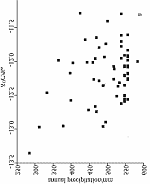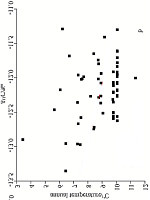First the link to this week’s complete list as HTML and as PDF.
This month’s J. Arch. Science contains two glaring examples of Cargo Cult, the imitation of the outward appearance of the scientific method without any real sense and understanding of it’s purpose and substance. Pretending to describe the tool used for cutting her sample teeth Burt only names the maker of its electric drive. Even if that were at all relevant, which it isn’t, they produce quite a range of different drives and it would be the type, not the maker’s trade mark, we’d need to be given. In all probability the real tool used is a grinding disk of 20–50 mm diameter and 0.5–1 mm thickness, possibly with a diamond coated edge. What we’d really like to know is how Burt prevented the heat generated from destroying her tissue. Just naming the maker and trade name of some apparatus instead of telling us what it does, is something frequently seen from humanities-trained people dabbling in science. (Interestingly in her 2013 article with a co-author, her method is described much better.)
Assuming there really is a relationship between temperature or humidity and isotope fractionation, then the isotope has to be the dependent variable and not the other way round. That alone invalidates An’s figure 7 completely. In the following I’ve flipped the subfigures and eliminated distractions (click to enlarge):
Yes, there is a slight trend, both for temperature and for rainfall but it’s swamped by random variability and of little predictive value. As to subfigure c, the flipped view makes its ridiculousness completely apparent.
At first glance Guinote et al.’s result is trivial, something folk wisdom, folk tales and literary works have always known and described. Not so. In this randomized trial status was arbitrarily assigned. What we see there is a direct causation irrespective of personality. So it is not, or at least nor only, a given personality working both ways, towards high status and to suppressing prosociality. It’s the status itself, a social construct, to blame, not personality, inherited or otherwise.
Perhaps the symbolic significance of the Gethsemane olive trees is greater with their age as determined by Bernabei as it would have been, were they two thousand years old. It reminds me of the magnificent fruit tree planting program launched by Jewish settlers in Israel.
There are quite a few questions to be asked about Burt and her conclusions, but as Reynard & Tuross pose them much better than I could, I need not bother here.
Although today’s climate in the Levant is significantly colder and drier than any time in the Bronze Age and thus not directly comparable, I do notice that Soto-Berelov et al. show today’s distribution of vegetation zones to be similar to that of the short-lived, 100–200 a optimum of 3900–4000 BP. The lower wooded area is probably due to the anthropogenic soil degradation of the past centuries. If so, today’s favourable conditions may turn out to be short lived too and Israel’s effort in soil amelioration and reforestation may become all the more important. This is Tikkun olam at its best.
Morgan et al. use modern adult students for their trial, people who have lived in a speech and language dominated society all their lives. There are indications that even the very recent writing has already resulted in genetic selection (Frost 2008, list of 2014-01-04), how much more so language, which we’ve had for at least 40 ka. So the fact that today’s students are best instructed verbally is completely meaningless for the conditions obtaining in the Oldovan.
Unfortunately Park & Reichert do not discuss at all how the “cast iron” of the ingots with only 2 % carbon may have been produced. Was this a variant of the (disputed) African “direct steel” process or had the Chinese already mastered the decarbonization through puddling?


